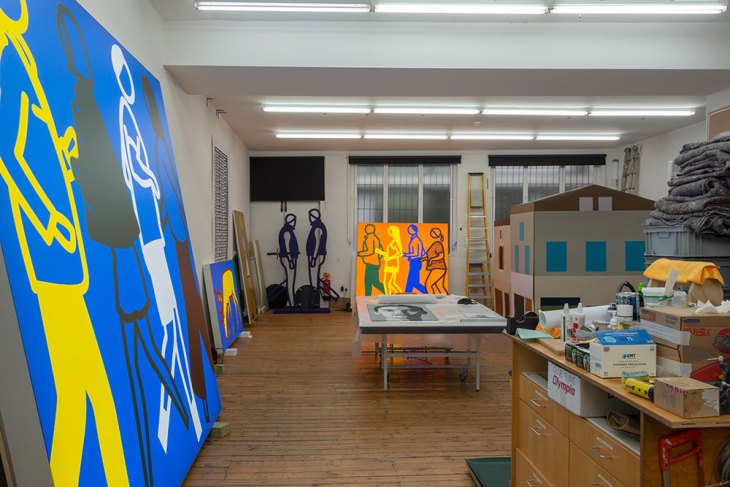With their distinctive linear style, Julian Opie’s sculptures, paintings and films are instantly recognisable. His works explore the relationship of our bodies to the spaces we inhabit – and in particular the urban environments in which his art is frequently shown. A series of new works, made in the past year, is currently on view at Lisson Gallery in London (until 12 June) and another solo exhibition is scheduled to open at Pitzhanger Manor & Gallery next month (25 June–24 October).
Where is your studio?
In Shoreditch, just up from Liverpool Street Station. This feels like a typical place to have an art studio now but when I bought it in 1987 it seemed so remote. I love this area and have used it in numerous works, including the current show at Lisson Gallery on Cork Street. We also rent a railway arch in London Fields.
What do you like most about the space?
It’s a 19th-century warehouse on four floors with steep stairs and a Mary Poppins roofscape above. I use the top floor, which has a high church-style ceiling and skylights. It’s quiet and calm but I can trot downstairs and talk to various colleagues on the other floors when necessary.
What frustrates you about it?
Nothing really. I wish I had bought the next-door building as well.
A view of Julian Opie’s studio in London. © Julian Opie

Do you work alone?
No, I work with ten others – technicians and three managers – and we regularly use a range of factories and of course a number of galleries.
How messy is your studio?
Spotless.
What’s the weirdest object in there?
Define ‘weird’. I collect other people’s art, some of which is in my studio and – since these are from around the world and into the past – these might be thought of as the weirder objects. I have a collection of Homo erectus stone hand axes on my desk and a group of beaded baby carriers from the Dayak tribe in Borneo.
Which artistic tool could you least do without?
Eyes? I make things in so many different ways – from laser-cut aluminium to LED panels, to mosaic and acrylic – that no one tool dominates. I am pretty lost when my computer crashes.
Old Street December 11 (2021), Julian Opie. Courtesy Lisson Gallery; © Julian Opie

What’s the most well-thumbed book in your studio?
Pre-websites my work was best recorded in exhibition catalogues, so when researching we often go back to these. I have a book of 19th-century woodblock printed landscapes by Hiroshige on my desk that I flick through – an image a day – for enjoyment and inspiration. It was already well-thumbed when I bought it.
What’s your typical studio lunch?
Pret.
What do you listen to while you’re working?
Spa sounds, relaxation tapes and nature sound CDs mostly. Actual music is too distracting. I use music and sound in some of my works so then I switch to those.
Do you ever sleep in your studio?
I did for a period of quarantine. A lot of noisy clubbers outside but nice to jog down to the Thames.
Is anything (or anyone) banned from your studio?
I ask my staff not to pass judgement on any of the works, positive or otherwise, as this confuses me. No office lingo or abbreviations and I try to keep visitors to a bare minimum.
‘Julian Opie’ is at Lisson Gallery, London, until 12 June.



